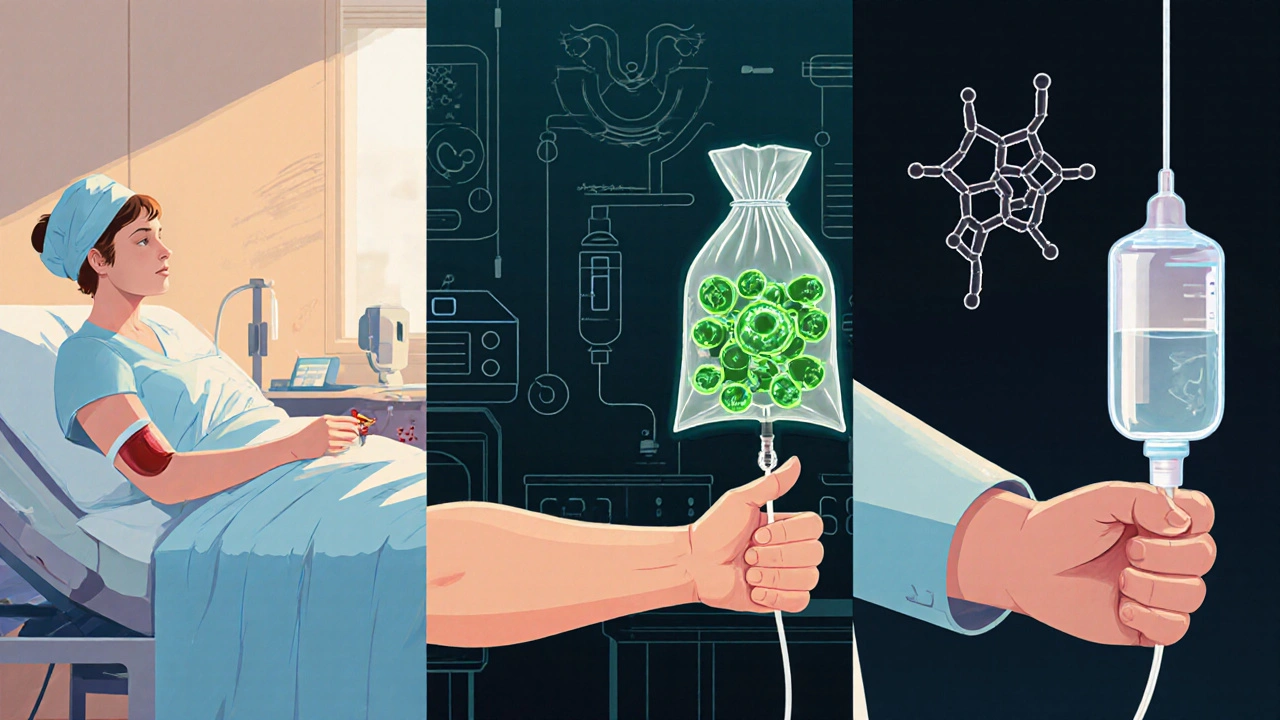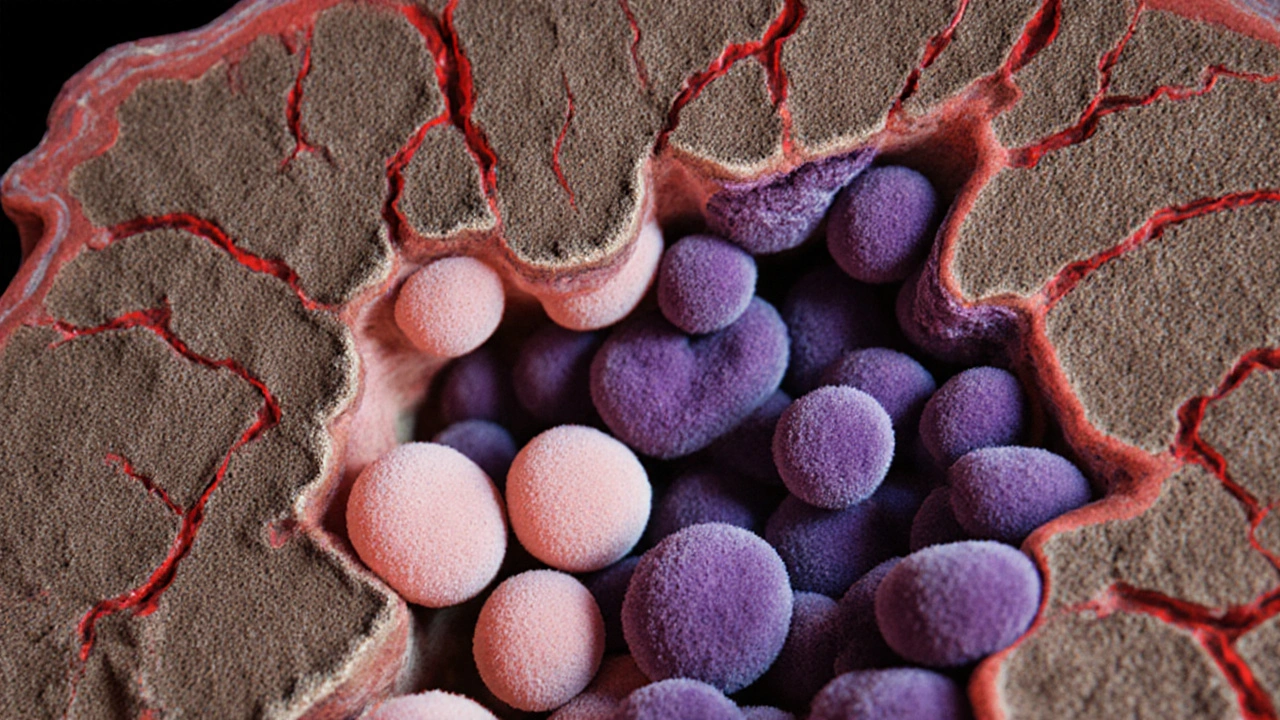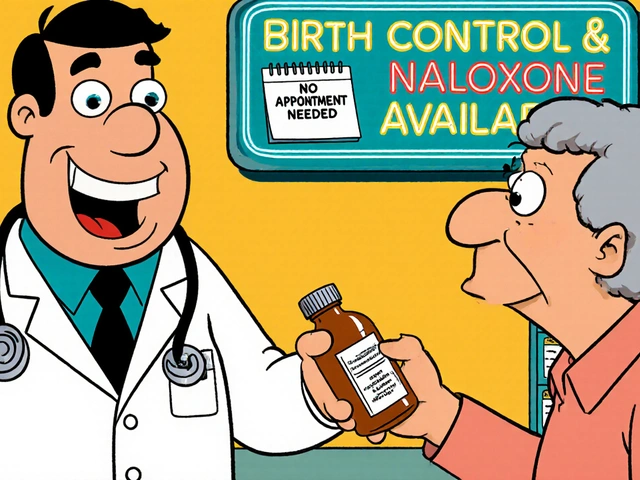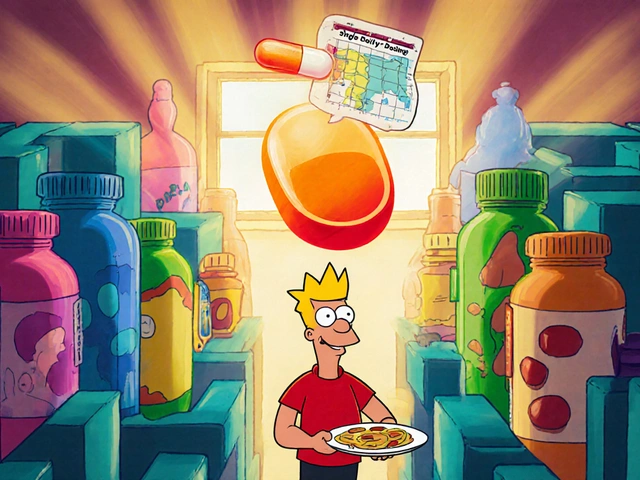Multiple Myeloma Treatment Eligibility Calculator
This calculator helps you understand which treatment options might be appropriate for your specific situation based on key medical criteria. Please note: This tool is for informational purposes only and should not replace professional medical advice. Always discuss treatment options with your oncologist.
Treatment Eligibility Results
Key considerations:
- Stem cell transplants are typically for patients under 70 with good kidney function
- CAR-T therapy is usually for relapsed/refractory disease after two prior lines
- Proteasome inhibitors and IMiDs are commonly used in first-line treatment
Key Takeaways
- Multiple myeloma is a cancer of plasma cells that lives in the bone marrow.
- New therapies like CAR‑T and newer proteasome inhibitors have extended median survival beyond 10 years for many patients.
- Personal stories show that hope, early detection, and strong support networks dramatically improve quality of life.
- Knowing which treatment option fits your disease stage and health profile is crucial - discuss transplant eligibility, clinical trials, and side‑effect management with your team.
- Practical coping tools include nutrition plans, exercise routines, mental‑health resources, and local support groups.
Facing a diagnosis of multiple myeloma can feel like stepping into a storm you never expected. Yet, every year dozens of Australians hear news that their condition is being managed better than ever before, thanks to breakthroughs in therapy and a growing community of survivors sharing what truly works. This article pulls together the science, the latest treatment options, and real‑world stories of people who have turned a daunting prognosis into a journey of resilience.
What Is Multiple Myeloma?
Multiple Myeloma is a malignant disease of plasma cells that originates in the bone marrow. These cells normally produce antibodies, but when they become cancerous they crowd out healthy blood‑forming cells, weaken bones, and release abnormal proteins that damage kidneys.
Plasma cells are a type of white blood cell that matures in the bone marrow. In multiple myeloma, they proliferate uncontrollably, forming lesions that cause bone pain and fractures.
The disease accounts for about 1% of all cancers worldwide, with an incidence of roughly 8 cases per 100,000 Australians each year. While there is no cure yet, median survival has risen from under three years in the 1990s to more than ten years for many patients thanks to modern therapies.

Recent Advances in Treatment
Over the past decade, three major therapeutic classes have reshaped the myeloma landscape: proteasome inhibitors, immunomodulatory drugs (IMiDs), and cellular therapies such as CAR‑T. Below is a concise comparison of the most common options for patients at different stages.
| Treatment | Typical Use | Key Benefit | Major Side Effects |
|---|---|---|---|
| Autologous Stem Cell Transplant | Eligible patients under 70, usually after induction therapy | Can double progression‑free survival | Infection risk, fatigue, mucositis |
| CAR‑T Therapy | Relapsed or refractory disease after two prior lines | High response rates, including deep remissions | Cytokine release syndrome, neurotoxicity |
| Proteasome Inhibitor (e.g., Bortezomib, Carfilzomib) | First‑line or combination regimens | Targets cancer‑cell protein degradation pathway | Peripheral neuropathy, hypertension |
| Immunomodulatory Drug (e.g., Lenalidomide) | Maintenance after transplant or in combos | Enhances immune surveillance | Blood clots, neutropenia |
Choosing the right regimen depends on disease stage, kidney function, age, and personal preferences. Discuss with a hematologist whether a transplant is feasible, if you qualify for a clinical trial, or whether a newer CAR‑T product like ide‑cel (bb2121) might be appropriate.
Stories of Hope - Real Voices From the Frontline
Statistics tell part of the story, but listening to those who have lived it adds the human dimension. Below are three anonymized accounts that illustrate different pathways to resilience.
Emma, 42 - From Diagnosis to a New Normal
Emma was diagnosed after a routine blood test revealed high protein levels. “I thought I’d never run after my kids again,” she recalls. Within weeks she started a regimen of a proteasome inhibitor plus lenalidomide and underwent an autologous stem‑cell transplant. Today, three years later, Emma runs a local marathon and volunteers at a cancer support group. Her secret? “Stay active, lean on my family, and ask my doctor about nutrition counseling early on.”
James, 58 - Finding Strength Through Clinical Trials
After two rounds of standard therapy, James’ disease relapsed. He enrolled in a phaseII trial evaluating a bispecific antibody targeting BCMA. “The trial gave me access to a treatment that helped shrink my tumor dramatically,” he says. James now participates in a research advisory board, helping shape future trials for other Australians.
Lena, 69 - Embracing Community Support
Lena’s journey took a turn when kidney complications forced dose reductions. She turned to a support group hosted by the Myeloma Australia charity. “Sharing worries with people who truly understand saved my mental health,” she notes. Lena also practices gentle yoga and uses a low‑protein diet to protect her kidneys, which she says are essential lifestyle tweaks for quality of life.

Coping Strategies & Resources
Beyond medical treatment, everyday actions can boost resilience. Here are evidence‑based tips that many survivors incorporate into their routine.
- Nutrition: Aim for a balanced diet rich in lean protein, calcium‑rich foods, and adequate hydration. Limit high‑salt foods to protect kidney function.
- Exercise: Light resistance training and walking improve bone density and reduce fatigue. Consult a physiotherapist familiar with myeloma patients.
- Mental health: Mindfulness, counseling, and peer‑support groups (like the support group mentioned above) lower anxiety and depression scores.
- Clinical trials: Australia hosts more than 200 myeloma‑related trials. Ask your oncologist about eligibility; trial participation often grants early access to cutting‑edge drugs.
- Financial aid: The Australian Government’s Chronic Disease Management Plan can subsidize allied‑health visits.
Keep a dedicated notebook (or digital app) to track appointments, medication side‑effects, and questions you want to raise during each clinic visit.
Practical Checklist for Newly Diagnosed Patients
- Confirm diagnosis with bone‑marrow biopsy and cytogenetic testing.
- Ask about eligibility for autologous stem cell transplant - age, kidney function, and performance status matter.
- Discuss treatment goals: curative intent vs. disease control, and align with personal life priorities.
- Review potential side‑effects of each drug class; arrange prophylactic measures (e.g., antivirals for proteasome inhibitors).
- Enroll in a reputable support group or online community.
- Explore current clinical trials on the Myeloma Australia website.
- Set up a nutrition and exercise plan with a dietitian and physiotherapist.
- Schedule regular mental‑health check‑ins - a psychologist experienced in oncology can be invaluable.
Frequently Asked Questions
What are the early signs of multiple myeloma?
Common early symptoms include persistent bone pain (often in the back or ribs), unexplained fatigue, frequent infections, and elevated calcium levels. Lab tests may show a high amount of monoclonal protein (M‑protein) in the blood.
Can multiple myeloma be cured?
Currently, the disease is considered incurable, but many patients achieve long‑term remission. Ongoing research aims to develop curative approaches, especially with CAR‑T and bispecific antibodies.
How does CAR‑T therapy work for myeloma?
CAR‑T involves collecting a patient’s T‑cells, genetically modifying them to express a chimeric antigen receptor that targets the BCMA protein on myeloma cells, then infusing them back. The engineered T‑cells seek and destroy cancer cells, often producing deep responses.
What lifestyle changes help manage side effects?
Staying hydrated, eating a protein‑rich but low‑salt diet, gentle resistance exercise, and using stress‑reduction techniques like meditation can lessen fatigue, neuropathy, and kidney strain.
Where can I find Australian myeloma support groups?
Myeloma Australia runs both in‑person and virtual groups across major cities, including Perth. The organization also offers counseling services and educational webinars.

 Buy Cheap Generic Cialis Online - Safe Guide 2025
Buy Cheap Generic Cialis Online - Safe Guide 2025
 Can betamethasone help with hair loss? Exploring its potential benefits
Can betamethasone help with hair loss? Exploring its potential benefits
 Pharmacist Substitution Authority: Understanding Scope of Practice in the U.S.
Pharmacist Substitution Authority: Understanding Scope of Practice in the U.S.
 Amaryl (Glimepiride) vs. Alternatives: Detailed Comparison for Type 2 Diabetes
Amaryl (Glimepiride) vs. Alternatives: Detailed Comparison for Type 2 Diabetes
Ashley Helton
October 12, 2025 AT 19:51Well, if surviving multiple myeloma were a hobby, I'd be a pro by now.
Alex Mitchell
October 13, 2025 AT 21:21Thanks for pulling the info together – it’s actually pretty helpul 😊 (sorry if I’m a bit clumsy with the typing).
Amanda Jennings
October 14, 2025 AT 22:51Stay strong, keep moving, and remember that every tiny victory adds up to big hope!
alex cristobal roque
October 16, 2025 AT 00:21When you look at the eligibility calculator, the first thing that jumps out is how age and kidney function dominate the decision tree.
Patients under 70 with an eGFR above 45 mL/min are typically considered for autologous stem‑cell transplant, which can double progression‑free survival.
For those who have already tried two lines of therapy and have advanced disease, CAR‑T becomes a realistic option, offering deep remissions in many cases.
Proteasome inhibitors like bortezomib or carfilzomib remain cornerstone agents in first‑line regimens because they target the protein‑degradation pathway of myeloma cells.
Immunomodulatory drugs such as lenalidomide serve both as maintenance after transplant and as part of combination therapy, bolstering the immune response.
Side‑effect management is crucial: peripheral neuropathy from proteasome inhibitors can be mitigated with dose adjustments; blood‑clot risk from IMiDs calls for anticoagulation in high‑risk patients.
Nutrition plays a surprisingly big role; a low‑salt, adequate‑protein diet helps preserve kidney function, especially when eGFR is borderline.
Exercise, even light resistance training, improves bone density and reduces fatigue, two major concerns for myeloma patients.
Mental health support, such as mindfulness or counseling, correlates with better adherence to treatment schedules.
Clinical trial enrollment should be discussed early because many novel agents, including bispecific antibodies, are only available through trial protocols.
Financial assistance programs, like Australia’s Chronic Disease Management Plan, can offset costs of allied‑health visits.
Regular monitoring of monoclonal protein levels helps detect relapse before symptomatic progression.
When transplant isn’t feasible, double‑tandem therapy or sequential proteasome‑IMiD combinations can still provide durable control.
Patients should keep a detailed log of medications, side‑effects, and questions to bring to each oncology visit.
Ultimately, a personalized approach-balancing age, organ function, disease biology, and personal preferences-yields the best outcomes.
Bridget Dunning
October 17, 2025 AT 01:51Your comprehensive overview admirably synthesizes current therapeutic paradigms, notwithstanding the nuanced pharmacokinetic considerations inherent to proteasome inhibition.
Shweta Dandekar
October 18, 2025 AT 03:21It is absolutely imperative, dear readers, to recognize the ethical responsibility, which we all share, to advocate for equitable access to these life‑saving treatments, regardless of socioeconomic status.
Dominic Dale
October 19, 2025 AT 04:51One cannot ignore the shadowy machinations of pharmaceutical conglomerates, who undoubtedly prioritize profit over patient welfare, subtly steering clinical guidelines to favor exorbitant patented agents.
christopher werner
October 20, 2025 AT 06:21I appreciate the balanced perspective presented here.
Danielle Watson
October 21, 2025 AT 07:51good info keep it coming
Kimberly :)
October 22, 2025 AT 09:21I’ve seen patients thrive without the newest drugs 😊 but that doesn’t mean the hype is justified 🙃.
Sebastian Miles
October 23, 2025 AT 10:51Solid advice-stay active and monitor side effects.
Hoyt Dawes
October 24, 2025 AT 12:21Another generic health guide, nothing groundbreaking, just the same old buzzwords.
Jeff Ceo
October 25, 2025 AT 13:51Your criticism overlooks the genuine progress made; let’s focus on facts, not cynicism.
Jean-Sébastien Dufresne
October 26, 2025 AT 15:21Fellow Australians, let us celebrate our world‑class research institutions, which continuously propel multiple myeloma therapy forward, making us proud, dear mates! 🇦🇺
Patrick Nguyen
October 27, 2025 AT 16:51Note: adhere to the outlined checklist for optimal outcomes.
Patrick Bread
October 28, 2025 AT 18:21Indeed, because nothing says progress like another checklist.
Fiona Doherty
October 29, 2025 AT 19:51Honestly, these checklists are just paperwork; real care comes from listening to patients.